We’ve all witnessed the magic that happens when plants thrive in rich, nutrient-dense soil. But what if we told you there’s a way to achieve those lush gardens and bountiful harvests without relying on synthetic chemicals? Organic fertilizers are revolutionizing how we nourish our plants, offering a sustainable path to gardening success that benefits both our plants and the environment.
Unlike conventional fertilizers that provide quick fixes, organic options work in harmony with nature’s cycles. They feed not just our plants but the entire soil network, creating a foundation for long-term garden health. From kitchen scraps transformed into compost to specialized organic blends, these natural nutrients deliver everything your plants crave.
Whether you’re a seasoned gardener or just starting your green journey, understanding organic fertilizers will transform how you approach plant care. We’re about to discover the area of natural plant nutrition that’ll have your garden flourishing like never before.
Understanding Organic Fertilizer for Plants and Its Benefits
Building on our foundation of sustainable gardening practices, we’ll explore what sets organic fertilizers apart and why they’re transforming modern horticulture.
What Makes Fertilizer Organic
Organic fertilizers derive from natural materials that once lived or were produced by living organisms. Common sources include composted animal manure, bone meal, fish emulsion, seaweed extracts, and decomposed plant matter. These materials undergo natural decomposition processes that break down complex organic compounds into nutrients plants can absorb.
Certification standards define organic fertilizers as products containing at least 3% organic matter by weight. The Organic Materials Review Institute (OMRI) and similar organizations verify that fertilizers meet strict guidelines prohibiting synthetic chemicals, genetically modified organisms, and artificial additives. This certification ensures gardeners receive authentic organic products that align with sustainable growing practices.
Natural processing methods preserve beneficial microorganisms that synthetic fertilizers destroy. Composting, fermentation, and slow decomposition maintain living bacterial and fungal communities essential for nutrient cycling. These microorganisms form symbiotic relationships with plant roots, improving nutrient uptake efficiency by up to 40% compared to synthetic alternatives.
Environmental Advantages Over Synthetic Options
Organic fertilizers reduce chemical runoff that contaminates waterways and groundwater supplies. Studies show that synthetic nitrogen fertilizers contribute to 60% of water pollution in agricultural areas, creating dead zones in lakes and rivers. Organic alternatives release nutrients slowly through microbial activity, preventing the rapid leaching that causes environmental damage.
Carbon sequestration increases significantly when gardens use organic fertilizers regularly. Compost-based fertilizers can store up to 2.6 tons of carbon per acre annually in soil organic matter. This carbon storage helps combat climate change while improving soil structure and water retention capacity in garden beds.
Beneficial insect populations thrive in gardens treated with organic fertilizers. Research indicates that organic growing methods support 50% more beneficial insects than synthetic approaches. These insects include pollinators like bees and butterflies, plus natural predators that control pest populations without chemical interventions.
Long-Term Soil Health Improvements
Soil structure improves dramatically through consistent organic fertilizer applications. Organic matter increases soil aggregation, creating stable clusters of particles that enhance water infiltration and root penetration. Gardens using organic fertilizers show 25% better soil structure scores compared to those relying on synthetic chemicals.
Microbial diversity flourishes in soils enriched with organic fertilizers. Healthy soil contains over 1 billion microorganisms per gram, including bacteria, fungi, protozoa, and nematodes. Organic fertilizers feed these organisms, creating a robust soil food web that cycles nutrients efficiently and protects plants from diseases naturally.
Water retention capacity increases by up to 20% in organically fertilized soils. Enhanced organic matter content helps soil hold moisture longer during dry periods while improving drainage during heavy rains. This improved water management reduces irrigation needs and prevents both drought stress and waterlogging issues in garden plants.
Compost: The Gold Standard of Organic Fertilizer for Plants

Compost stands as the most effective organic fertilizer we can use, transforming ordinary kitchen scraps and yard waste into nutrient-rich soil amendments. Research shows that applying compost significantly increases vital soil nutrients including total nitrogen, available phosphorus, available potassium, and organic matter content.
How to Create Nutrient-Rich Compost at Home
Collecting the right materials forms the foundation of successful home composting. We need to balance green materials like vegetable scraps and grass clippings with brown materials such as dried leaves, straw, and shredded paper. Green materials provide nitrogen while brown materials supply carbon, creating the perfect environment for decomposition.
Maintaining proper moisture levels ensures our compost pile stays active and productive. We should keep the pile damp like a wrung-out sponge, adding water during dry periods and covering it during heavy rains. Too much moisture creates anaerobic conditions that slow decomposition and create unpleasant odors.
Turning the pile regularly provides essential oxygen that speeds up the breakdown process. We can use a pitchfork or compost aerator to mix materials every 1-2 weeks, bringing oxygen to the center where microbial activity is most intense. This simple step accelerates decomposition and prevents the pile from becoming compacted.
Positioning our compost bin in a warm, partially shaded location encourages optimal microbial activity. Direct sunlight can dry out the pile too quickly, while complete shade may slow the process. A location that receives morning sun and afternoon shade typically works best for consistent decomposition rates.
Best Materials for Composting Success
Green materials provide essential nitrogen and include kitchen vegetable scraps, coffee grounds, fresh grass clippings, and garden waste. We can add fruit peels, vegetable trimmings, eggshells, and even tea bags to boost nitrogen content. These materials break down quickly and fuel the decomposition process.
Brown materials supply carbon and structure to our compost pile through dried leaves, straw, cardboard, and shredded newspaper. We should tear or shred larger items like cardboard boxes to help them decompose faster. These materials create air pockets that improve airflow throughout the pile.
Avoiding certain materials prevents problems and maintains compost quality. We shouldn’t add meats, dairy products, or diseased plants as these can attract pests and introduce harmful pathogens. Pet waste, weeds with seeds, and chemically treated materials also don’t belong in our compost pile.
Balancing green and brown materials in roughly a 1:3 ratio by volume ensures efficient decomposition. We can adjust this ratio based on what materials we have available, but maintaining some balance prevents our pile from becoming too wet or too dry.
Timeline and Maintenance Requirements
Expecting results within 2 to 6 months helps us plan our composting schedule effectively. Factors like materials used, pile size, temperature, moisture levels, and turning frequency all influence how quickly our compost finishes. Smaller pieces decompose faster than larger chunks, so chopping materials beforehand speeds the process.
Monitoring temperature indicates whether our pile is working properly. Active compost piles heat up to 130-160°F in the center due to microbial activity. We can use a compost thermometer to check temperatures and determine when to turn the pile for optimal results.
Recognizing finished compost saves us from applying immature material to our gardens. Ready compost appears dark and crumbly with an earthy smell, similar to rich forest soil. We shouldn’t see recognizable pieces of the original materials, and the compost should feel cool to the touch.
Harvesting our finished compost involves screening it through a coarse mesh to remove any large, undecomposed pieces. We can return these pieces to our next compost pile and use the fine, dark material immediately in our gardens. This nutrient-rich amendment improves soil structure, increases water retention, and provides steady nutrition throughout the growing season.
Manure-Based Organic Fertilizers for Maximum Plant Growth
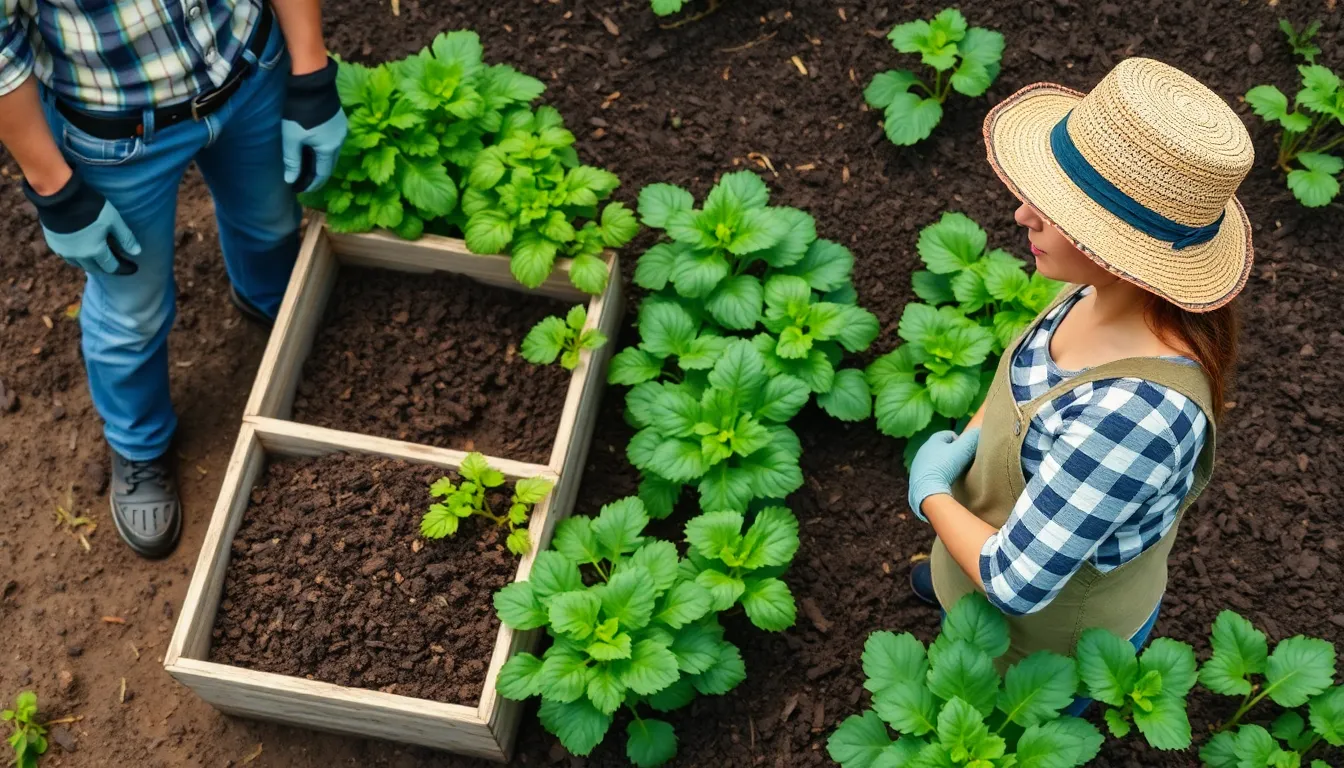
Animal manure stands out as one of the most nutrient dense organic fertilizers available to gardeners and farmers. We’ve found that manure based fertilizers deliver exceptional results when properly selected and applied to support maximum plant growth.
Choosing the Right Animal Manure Types
Poultry manure delivers the highest nitrogen content among common manure types, making it ideal for crops requiring quick nutrient release and rapid growth. We recommend chicken manure for leafy greens like lettuce, spinach, and kale that benefit from immediate nitrogen availability.
Cow manure provides moderate nutrient levels with excellent soil structure improvement capabilities. This balanced option works well for most vegetable gardens and flower beds where steady nutrient release supports consistent plant development.
Horse manure offers similar benefits to cow manure but typically contains fewer weed seeds due to horses’ digestive processes. We find this type particularly valuable for establishing new garden beds and improving clay or sandy soils.
Sheep manure contains concentrated nutrients in smaller pellets that break down gradually, providing sustained feeding for perennial plants and fruit trees. The compact nature makes it easy to handle and distribute evenly throughout garden spaces.
| Manure Type | Nitrogen Content | Best Uses | Key Benefits |
|---|---|---|---|
| Poultry | Highest | Leafy greens, quick growth crops | Rapid nutrient release |
| Cow | Moderate | General vegetable gardens | Soil structure improvement |
| Horse | Moderate | New garden beds | Fewer weed seeds |
| Sheep | Concentrated | Perennials, fruit trees | Sustained feeding |
Proper Aging and Preparation Methods
Fresh manure requires proper aging before application to prevent plant damage from high ammonia levels and potential pathogens. We never apply fresh manure directly to growing plants as it can burn roots and introduce harmful bacteria.
Composting manure for several months under aerobic conditions stabilizes nutrients and eliminates most pathogens and weed seeds. Turn the compost pile regularly to maintain oxygen flow and accelerate the decomposition process.
Temperature monitoring ensures effective composting as properly managed piles reach 140°F to 160°F during active decomposition. This heat kills harmful organisms while preserving beneficial microorganisms essential for plant health.
Liquid organic fertilizers from aged manure create excellent foliar feeds and soil drenches that improve nutrient uptake. Steep aged manure in water for 24 to 48 hours, then strain the liquid for easy application through watering systems.
Visual and smell indicators confirm readiness when aged manure appears dark brown, crumbles easily, and smells earthy rather than pungent. Well aged manure should not generate heat when you squeeze a handful in your palm.
Application Rates and Timing Guidelines
Application rates depend on manure nutrient content and exact crop requirements, with most vegetables needing 100 to 150 pounds of nitrogen per acre for optimal growth. We calculate application amounts based on soil tests and plant nutrient demands rather than using generic recommendations.
Timing applications before planting maximizes nutrient availability during critical early growth stages when plants establish root systems. Apply aged manure 2 to 4 weeks before seeding or transplanting to allow nutrients to integrate with existing soil.
Split applications throughout the growing season provide steady nutrition for heavy feeding crops like tomatoes, corn, and squash. We typically apply half the total amount at planting and divide the remainder into 2 to 3 applications during active growth periods.
Seasonal application guidelines vary by climate and crop type, with spring applications supporting new growth and fall applications building soil organic matter over winter. Avoid applying manure to frozen ground where runoff risks increase significantly.
Environmental considerations prevent nutrient runoff that can harm waterways and surrounding ecosystems. We maintain buffer zones near water sources and avoid applications before heavy rainfall events that could wash nutrients away from target areas.
Fish Emulsion: A Powerful Liquid Organic Fertilizer for Plants
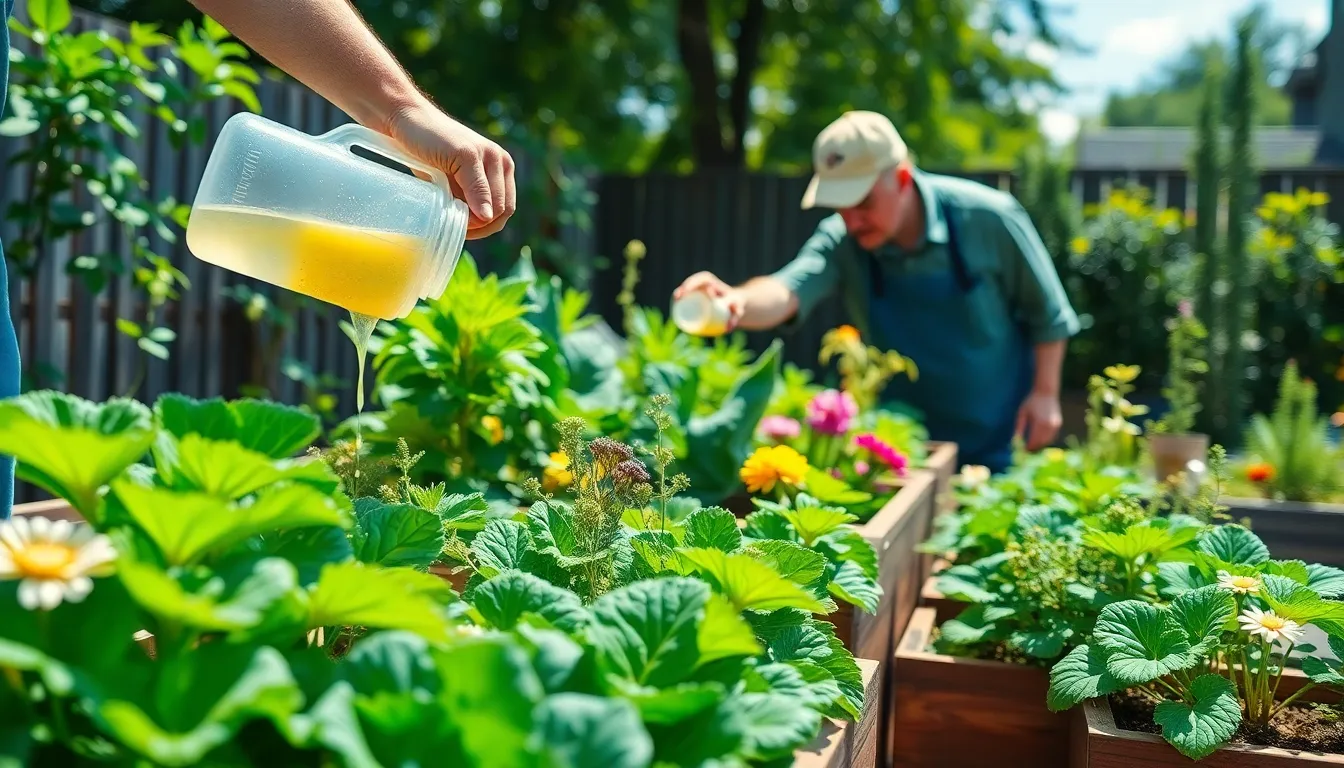
Fish emulsion stands out as one of nature’s most effective liquid organic fertilizers, offering concentrated nutrition that plants can absorb quickly. This liquid gold transforms fish processing byproducts into a nutrient-rich solution that delivers immediate results while maintaining our commitment to organic gardening principles.
Nutritional Benefits for Different Plant Types
Fish emulsion provides a balanced supply of essential nutrients that support diverse plant needs across our gardens. Nitrogen content promotes lush, green foliage development in leafy vegetables like lettuce, spinach, and kale. Phosphorus supports robust root systems and encourages flowering in tomatoes, peppers, and ornamental plants. Potassium enhances overall plant health while building disease resistance and drought tolerance throughout the growing season.
Trace minerals in fish emulsion improve metabolic functions and strengthen plant resilience against environmental stresses. Leafy greens respond particularly well to fish emulsion’s nitrogen-rich profile, producing larger leaves and extended harvest periods. Flowering plants benefit from the phosphorus content, developing more abundant blooms and stronger fruit sets. Vegetable crops show improved yields and enhanced quality when we incorporate fish emulsion into our regular feeding schedule.
Soil microbial activity increases significantly when we apply fish emulsion, creating better nutrient cycling and improved availability of essential elements. Beneficial microorganisms thrive on the organic matter in fish emulsion, establishing a healthier soil network that supports long-term plant health.
Mixing and Application Techniques
Fish emulsion requires proper dilution before application to prevent plant damage and ensure optimal nutrient uptake. We typically mix 1-2 tablespoons of fish emulsion per gallon of water for most applications. Foliar feeding delivers nutrients directly through plant leaves, providing rapid absorption and immediate results for stressed or nutrient-deficient plants.
Soil drenching applications enrich the root zone while stimulating beneficial microbial growth around plant bases. We apply diluted fish emulsion every 1-2 weeks during active growing seasons for consistent nutrition. Early morning applications work best for foliar feeding, allowing leaves to absorb nutrients before afternoon heat causes rapid evaporation.
Application timing coincides with periods of active growth when plants can use nutrients most effectively. Spring applications support initial growth spurts, while summer feedings maintain vigorous development through peak growing months. We avoid applying fish emulsion during dormant periods when plants can’t efficiently process the available nutrients.
Storage and Shelf Life Considerations
Fish emulsion maintains its nutrient quality when stored in cool, dark locations away from direct sunlight and temperature fluctuations. Properly sealed containers prevent nutrient degradation and minimize the characteristic odor associated with fish-based fertilizers. We shake containers thoroughly before each use to ensure even distribution of settled nutrients throughout the liquid.
Shelf life extends several months under proper storage conditions, though exposure to air, heat, or sunlight accelerates nutrient breakdown and product spoilage. Refrigerated storage can extend usability beyond manufacturer recommendations while maintaining fertilizer effectiveness. We monitor stored fish emulsion for changes in color, consistency, or smell that indicate product degradation.
Temperature control becomes critical during summer months when garage or shed storage can reach excessive heat levels. Basement storage or climate-controlled areas provide ideal conditions for maintaining fish emulsion quality throughout the growing season.
Bone Meal and Blood Meal for Targeted Plant Nutrition

Building on liquid fertilizers like fish emulsion, we can turn to two powerful dry organic options that deliver exact nutrients exactly where our plants need them most. Bone meal and blood meal represent targeted nutrition at its finest, each serving distinct purposes in our organic gardening arsenal.
Understanding NPK Ratios in Organic Options
Bone meal delivers a concentrated source of phosphorus with its typical NPK ratio of 3-15-0, making it our go-to choice for promoting robust root development and spectacular flowering. This slow-release fertilizer gradually feeds plants over several months, ensuring steady phosphorus availability for energy transfer and disease resistance. Blood meal packs a nitrogen punch with its impressive 12-0-0 ratio, providing rapid foliage development when our plants need quick greening.
Together, these meals create a balanced feeding system that addresses different growth phases throughout the season. We can combine bone meal’s long-term phosphorus supply with blood meal’s immediate nitrogen boost to support both vegetative growth and reproductive development. This strategic pairing eliminates the guesswork in organic plant nutrition while maintaining soil health.
Best Plants for Each Meal Type
Bone meal works exceptionally well for bulbs like tulips and daffodils, which require strong root systems and reliable flowering performance. Roses benefit tremendously from bone meal applications, developing stronger stems and more abundant blooms throughout the growing season. Fruiting plants such as tomatoes, peppers, and squash thrive with bone meal’s phosphorus content, which directly supports fruit set and development.
Blood meal excels with nitrogen-hungry crops like corn, which demands rapid growth and lush foliage during its vegetative phase. Leafy greens including spinach, lettuce, and kale respond quickly to blood meal applications, producing tender, vibrant leaves. Lawns experiencing nitrogen deficiency bounce back rapidly with blood meal treatments, especially after heavy rainfall that leaches nutrients from the soil.
We’ve found that timing matters significantly with both fertilizers. Blood meal works best during early growing seasons when plants focus on foliage development, while bone meal benefits plants throughout their entire growing cycle.
Safety Precautions and Handling Tips
Handle both fertilizers with gloves to prevent skin irritation, as these animal-derived products can cause sensitivity reactions in some gardeners. Blood meal’s distinctive odor attracts pets and wildlife, so we recommend incorporating it into the soil immediately after application rather than leaving it on the surface.
Over-application poses real risks with these concentrated fertilizers. Blood meal’s high nitrogen content can burn plant roots and foliage if we exceed recommended rates, while excessive bone meal creates phosphorus buildup that interferes with other nutrient uptake. We always conduct soil tests before application to determine actual nutrient needs.
Storage requires dry conditions to prevent spoilage and clumping that makes application difficult. Keep containers sealed tightly and store them away from moisture and temperature extremes. Fresh bone meal and blood meal should flow freely and maintain their characteristic appearance without mold or unusual odors.
Apply these fertilizers during calm weather to prevent drift and ensure accurate placement around target plants. We’ve learned that gentle watering after application helps activate the nutrients while preventing dust-related respiratory irritation during handling.
Kelp and Seaweed Fertilizers for Enhanced Plant Vitality
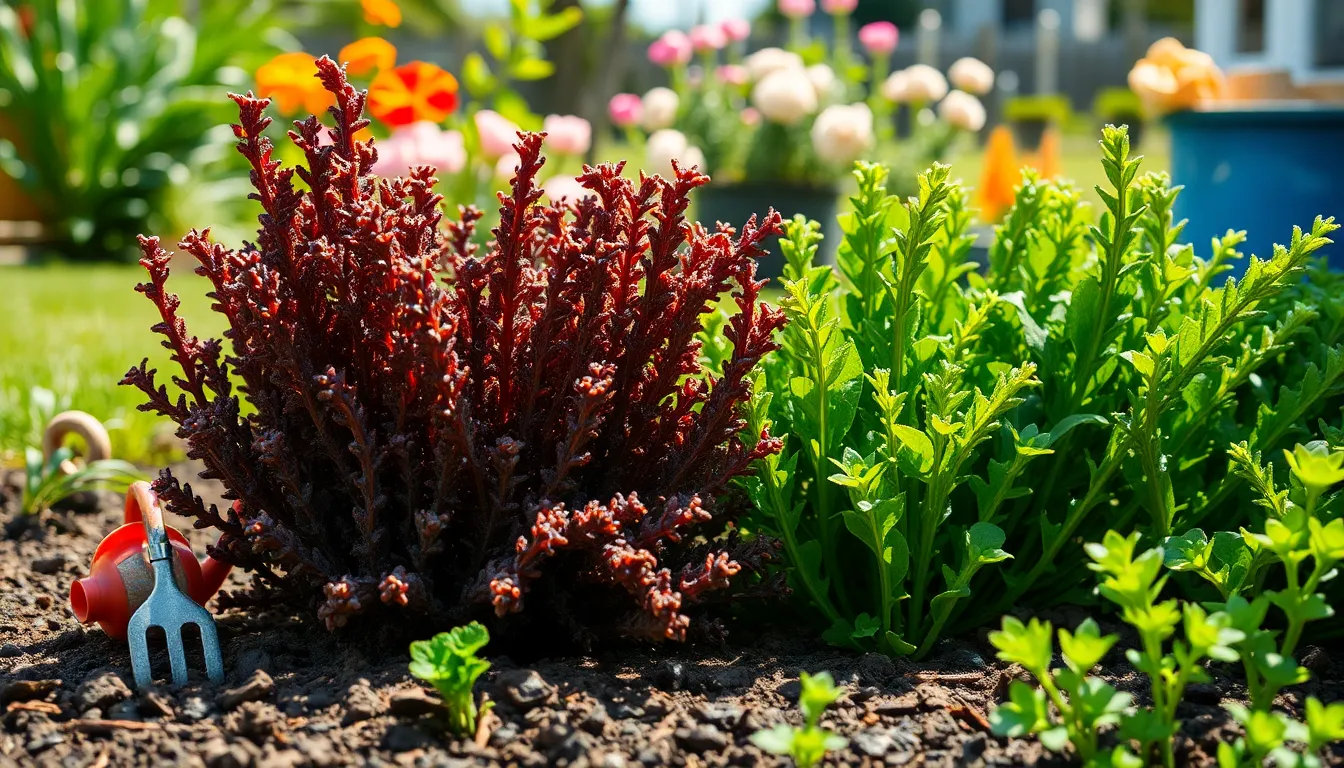
Ocean-derived fertilizers bring marine nutrients directly to our gardens, offering a unique combination of trace minerals and natural growth hormones. These seaweed-based amendments provide bioactive compounds that synthetic fertilizers simply can’t match.
Trace Minerals and Growth Hormones Present
Kelp fertilizers deliver essential micronutrients that are often missing from garden soils. These marine-based amendments contain iodine, potassium, magnesium, and calcium in forms that plants readily absorb. Natural growth hormones including cytokinins, auxins, and gibberellins work together to stimulate cell division and promote vigorous plant development.
Cytokinins enhance root growth and help plants resist environmental stress. These hormones improve nutrient uptake efficiency while promoting stronger root systems that can better access soil resources. Auxins support cell elongation and differentiation, leading to healthier stem and leaf development throughout the growing season.
Trace minerals from seaweed extracts fill nutritional gaps that conventional fertilizers miss. Many soils lack sufficient iodine and other micronutrients that kelp naturally provides. Plants receiving these marine-derived nutrients show improved resilience to drought, disease, and temperature fluctuations.
Application Methods for Different Garden Sizes
Small garden applications work best with liquid kelp extracts diluted for foliar spraying. Container plants and raised beds benefit from seaweed fertilizers mixed at ratios of 1-2 tablespoons per gallon of water. Apply these diluted answers every 2-3 weeks during active growing periods for optimal results.
Large garden and agricultural applications require concentrated liquid extracts delivered through irrigation systems. Field applications typically use 1-3 gallons of liquid kelp concentrate per acre, depending on crop type and growth stage. These concentrated forms provide cost-effective coverage for extensive planting areas.
Soil drench applications deliver nutrients directly to root zones in both small and large gardens. Pour diluted seaweed answers around plant bases to ensure deep soil penetration. Frequency depends on plant needs and soil conditions, but monthly applications during growing season provide steady nutrition.
Incorporation into compost and soil amendments offers gradual nutrient release for season-long feeding. Mix dried kelp meal into compost piles or blend with other organic materials before planting. This method provides sustained nutrition that supports plant development from germination through harvest.
Compatibility with Other Organic Amendments
Kelp fertilizers combine exceptionally well with compost to create synergistic soil improvements. When mixed together, these amendments increase total nitrogen, available phosphorus, and potassium content while boosting organic matter levels. This combination also enhances water retention capacity and supports beneficial microbial activity essential for nutrient cycling.
Manure-based fertilizers pair effectively with seaweed extracts to provide comprehensive plant nutrition. The combination delivers both macro and micronutrients while improving soil structure and microbial diversity. These partnerships create balanced feeding programs that support both immediate plant needs and long-term soil health.
Biochar integration with kelp fertilizers enhances nutrient availability and soil carbon storage. This combination improves enzymatic activity in soil while providing slow-release nutrition throughout growing seasons. The pairing also increases the soil’s ability to retain both water and nutrients, reducing the need for frequent applications.
Compatibility extends to other organic amendments like bone meal and fish emulsion without nutrient conflicts. These combinations allow us to create customized feeding programs that address exact plant requirements. The natural pH buffering capacity of kelp helps maintain optimal soil conditions when using multiple organic inputs together.
Worm Castings: Nature’s Perfect Organic Fertilizer for Plants
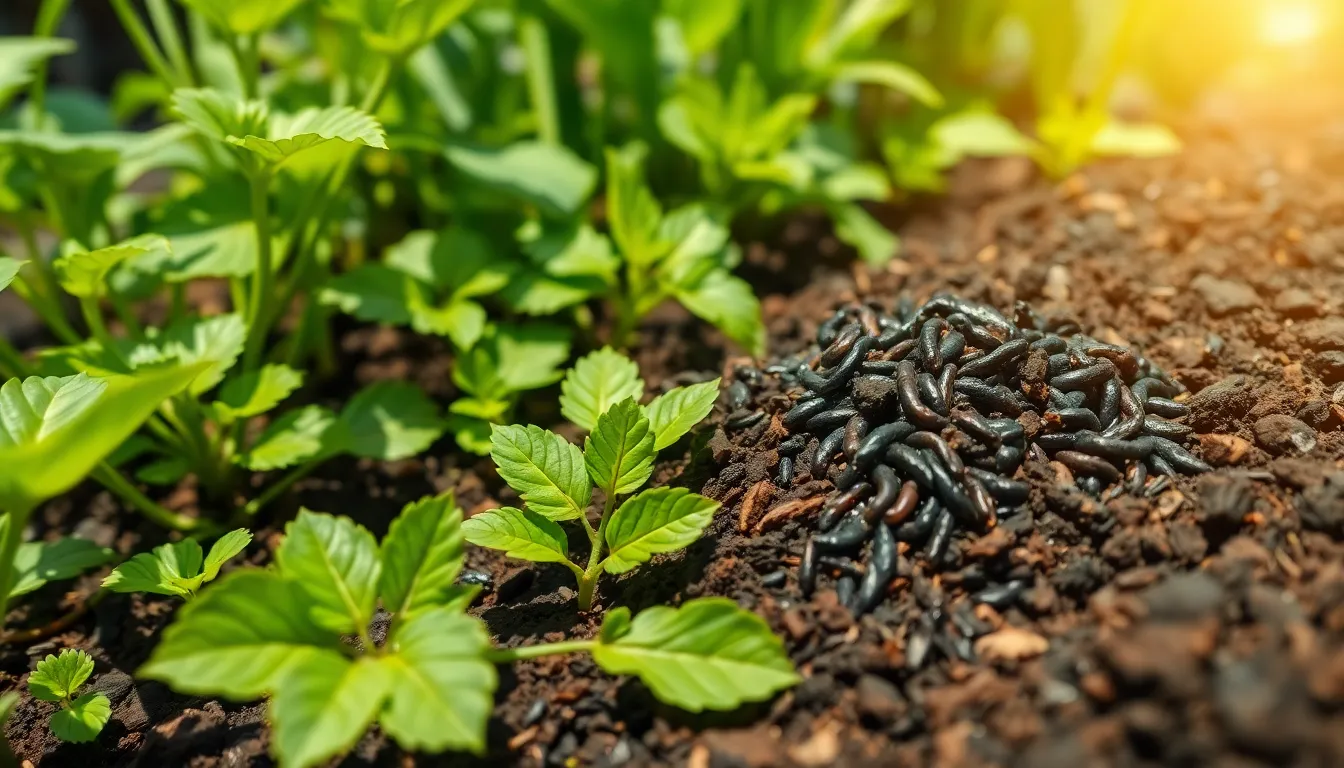
We’re about to explore one of the most remarkable organic fertilizers available to gardeners. Earthworms transform organic materials into nutrient-rich castings that contain essential minerals like nitrogen, phosphorus, potassium, magnesium, calcium, and trace elements in forms plants can immediately use.
Benefits of Vermicompost Over Traditional Compost
Nutrient delivery sets vermicompost apart from regular compost through its slow-release properties that prevent nutrient burn while enabling steady plant absorption. Traditional compost can’t match this controlled nutrient availability that feeds plants consistently over time.
Soil structure improvements occur when we add worm castings to our gardens because they make soil more porous and absorbent. Enhanced moisture retention reduces drying while creating ideal growing conditions that traditional compost simply can’t provide.
Beneficial microorganisms thrive in vermicompost with a wider diversity of helpful bacteria and fungi compared to regular compost. These microbes improve soil health and nutrient cycling more effectively than any other organic amendment we can create at home.
Plant performance dramatically increases when we use worm castings instead of synthetic fertilizers or regular compost. Studies demonstrate improved seed germination, enhanced seedling growth, and healthier plants with increased yields throughout the growing season.
Setting Up a Home Worm Bin System
Red worms (Eisenia fetida) work most efficiently for composting organic waste in our home systems. These specialized earthworms process kitchen scraps faster than regular garden worms and thrive in contained environments.
Container preparation requires a suitable bin with proper bedding materials like shredded paper or coconut coir. We’ll maintain consistent moisture levels while ensuring adequate aeration for optimal worm health and casting production.
Feeding schedules involve adding kitchen scraps such as vegetable peelings and fruit waste regularly while avoiding meats and dairy products. Proper feeding keeps our worms active and productive without creating odors or attracting pests.
Maintenance routines include monitoring moisture levels, adjusting bedding materials, and harvesting finished castings every few months. Regular care ensures our worm bin produces high-quality fertilizer consistently throughout the year.
Harvesting and Using Worm Castings Effectively
Harvesting techniques involve moving finished compost to one side of our bin while feeding worms on the opposite side to encourage migration. This separation method allows us to collect pure castings without disturbing our worm population.
Application methods include mixing worm castings directly into garden beds, potting soil, or using them as top dressing around established plants. We can also create liquid fertilizer by diluting castings in water for foliar feeding applications.
Safety advantages make worm castings ideal for all plant types because they maintain neutral pH levels and carry virtually no risk of burning sensitive roots. This gentle nature allows us to apply generous amounts without worrying about plant damage.
Versatile uses extend beyond soil amendments to include compost teas that promote flowering and fruiting in our gardens. The nutrient-dense, microbe-rich properties of worm castings support plant health while improving overall garden sustainability compared to traditional fertilizer methods.
Green Manure and Cover Crops as Living Fertilizers
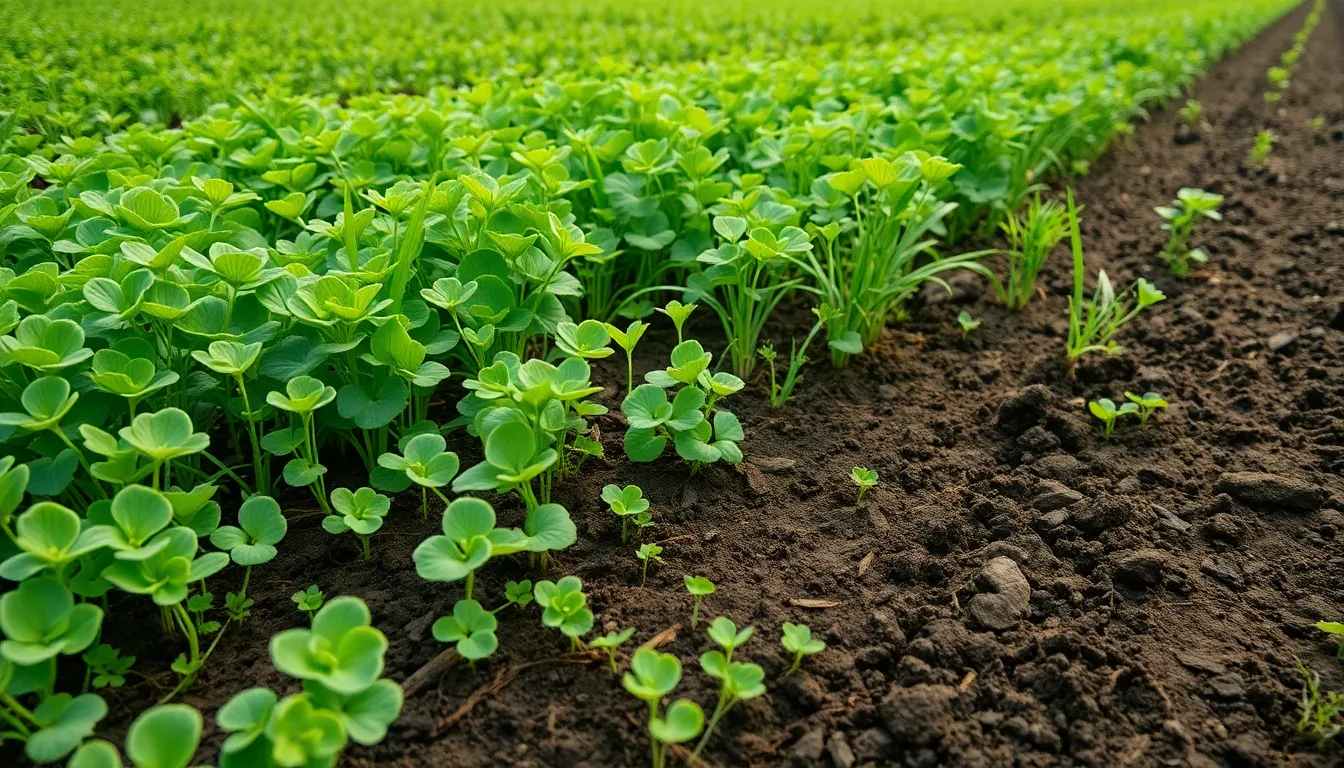
Living fertilizers offer us a sustainable approach to soil enhancement that goes beyond traditional composting methods. These specialized plants serve dual purposes by providing organic matter while actively improving soil conditions during their growth cycle.
Best Cover Crop Varieties for Soil Enhancement
Legume cover crops deliver exceptional nitrogen enrichment through their natural ability to fix atmospheric nitrogen into soil-available forms. Clover, vetch, and peas represent the most effective choices for building soil nitrogen reserves that reduce our dependence on synthetic fertilizers. These nitrogen-fixing plants establish symbiotic relationships with beneficial bacteria that convert atmospheric nitrogen into forms our garden plants can readily absorb.
Grass varieties like rye and oats excel at adding substantial organic matter to depleted soils. Winter rye produces extensive root systems that break up compacted soil layers while contributing important biomass when incorporated. Oats work particularly well as quick-growing options that suppress weeds and capture nutrients before they leach away.
Brassica cover crops provide unique pest and disease suppression benefits alongside soil improvement. Radishes, mustard, and turnips penetrate hardpan layers with their deep taproots while releasing natural compounds that reduce harmful soil pathogens. These cruciferous plants also scavenge nutrients from deep soil layers and bring them closer to the surface for future crops.
Timing for Planting and Incorporation
Optimal planting windows occur immediately after harvesting our main crops to maximize soil coverage and nutrient capture potential. Summer plantings following early vegetable harvests allow cover crops to establish before winter dormancy periods. Fall seeding provides extended growing seasons for cool-season varieties that continue developing throughout mild winter months.
Strategic incorporation timing focuses on the flowering stage when plants reach peak nutrient content before seed production begins. We should till cover crops into the soil 2-3 weeks before planting our next crop to allow proper decomposition and nutrient release. Spring incorporation works best for winter cover crops, while summer plantings typically get incorporated in late fall or early spring.
Seasonal considerations help us select appropriate varieties that match our local growing conditions and crop rotation schedules. Cool-season covers like crimson clover thrive in fall plantings and overwinter in moderate climates. Warm-season options such as buckwheat grow rapidly during summer months and can complete full cycles in just 6-8 weeks.
Nitrogen Fixation and Soil Structure Benefits
Atmospheric nitrogen conversion through legume root nodules provides measurable reductions in synthetic fertilizer requirements for subsequent crops. Research demonstrates that leguminous cover crops can fix 50-300 pounds of nitrogen per acre depending on variety and growing conditions. This biological process creates plant-available nitrogen forms that release gradually as organic matter decomposes.
Soil aggregation improvements result from increased organic matter integration that enhances water retention capacity and root penetration. Studies show that cover crop systems increase soil organic matter content and improve water-holding capacity compared to bare soil management. Enhanced porosity allows better air and water movement while reducing surface runoff and erosion risks.
Microbial activity enhancement occurs as decomposing cover crop residues provide food sources for beneficial soil organisms. Research indicates that organic fertilizers including cover crops increase soil enzyme activity and microbial populations that contribute to nutrient cycling processes. These biological improvements support crop nutrient uptake and can increase yields by up to 48.6% compared to conventional fertilization methods alone.
Commercial Organic Fertilizer Options and Brand Comparisons
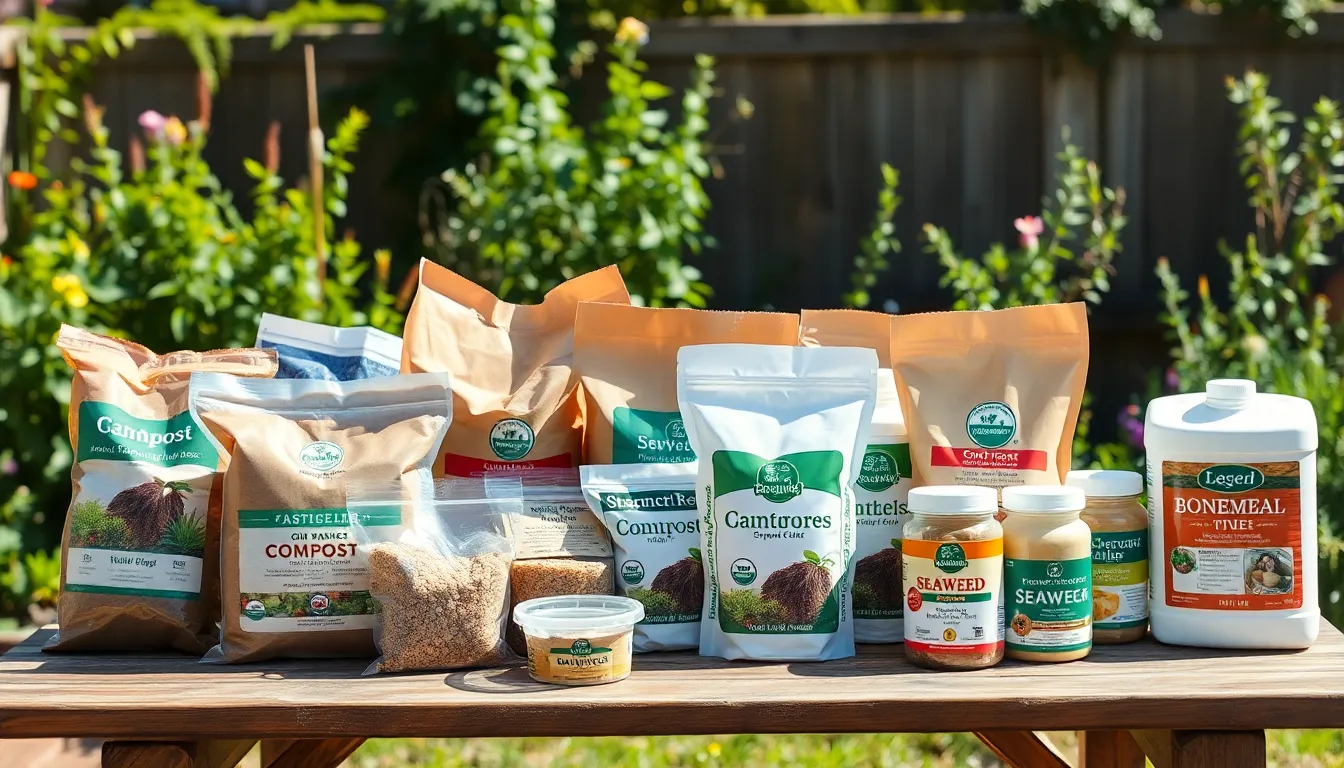
We’ve covered homemade options extensively, but commercial organic fertilizers offer convenience and specialized formulations that can complement our organic gardening approach.
Reading Labels and Understanding Certifications
Guaranteed Analysis provides the essential information we need when selecting organic fertilizers. This section displays the NPK percentages (nitrogen, phosphorus, potassium) that determine how the fertilizer will impact our plants’ growth and development.
USDA Organic certifications serve as our most reliable indicator of product quality and authenticity. These labels confirm that the fertilizer meets strict organic standards without synthetic chemicals or artificial additives that could harm our soil network.
OMRI-listed products represent another trusted certification system specifically designed for organic agriculture. We should look for this designation when choosing fertilizers for certified organic gardens or farms where compliance matters most.
Ingredient transparency helps us understand exactly what we’re adding to our soil. Quality manufacturers clearly list natural sources like composted plant matter, animal byproducts, bone meal, and seaweed extracts rather than hiding behind vague terminology.
Application instructions prevent the costly mistake of overfertilization that can damage plants and waste money. These guidelines specify proper dosage and timing based on the manufacturer’s testing and research data.
Cost-Effectiveness Analysis
Initial investment in organic fertilizers requires a higher upfront cost compared to synthetic alternatives, but the long-term benefits justify this expense through improved soil health and reduced irrigation needs.
| Fertilizer Type | Cost per lb | Cost per 1,000 sq ft |
|---|---|---|
| Compost | $0.15–0.25 | $15–25 |
| Cow Manure | $0.10–0.20 | $5–20 |
| Chicken Manure | $0.30–0.50 | $7.50–25 |
| Blood Meal | $1.50–3.00 | $15–30 |
| Bone Meal | $2.00–3.50 | $20–35 |
| Seaweed Extract | $8.00–15.00 | $8–30 |
Water retention improvements of up to 30% occur after consistent organic fertilizer use, dramatically reducing our irrigation costs over time. This enhanced moisture retention capability means we’ll spend less on water bills while maintaining healthier plant growth.
Reduced chemical inputs become possible as organic fertilizers build soil health naturally. We’ll find ourselves needing fewer pest control products and soil amendments as our garden network becomes more balanced and resilient.
Long-term soil investment pays dividends through improved structure, increased microbial diversity, and enhanced nutrient cycling that synthetic fertilizers simply can’t provide.
Top-Rated Products for Different Plant Categories
Vegetables and fruits thrive with compost and balanced organic blends that provide rich nitrogen and phosphorus content. These crops benefit from steady nutrient release that supports both foliage development and fruit production throughout the growing season.
Flowering plants respond exceptionally well to bone meal and blood meal combinations that promote vigorous blooming cycles. Blood meal delivers the nitrogen boost needed for healthy foliage while bone meal supplies phosphorus for abundant flower formation.
Acid-loving plants like blueberries, azaleas, and rhododendrons benefit from seaweed extracts that provide essential micronutrients and support beneficial soil microbes. These specialized fertilizers maintain the slightly acidic conditions these plants require for optimal growth.
Lawns and turf perform best with manure-based blends that enhance green growth sustainably without the chemical burn risks associated with synthetic lawn fertilizers. These products build soil structure while providing the nitrogen needed for thick, healthy grass growth.
Container plants require specialized organic blends with faster nutrient availability since potted plants can’t access the broader soil network. Look for products that combine quick-release and slow-release organic components for balanced nutrition.
Application Techniques for Organic Fertilizer Success

Getting the most from our organic fertilizers requires strategic application methods that maximize nutrient availability and plant uptake. Let’s explore the essential techniques that ensure our plants receive optimal nutrition throughout their growing cycles.
Soil Testing and Nutrient Assessment
Testing our soil before applying organic fertilizer helps determine existing nutrient levels and soil pH, enabling precise nutrient management. We recommend conducting soil tests annually or before starting new planting projects to understand what our gardens truly need.
Organic materials vary widely in nutrient content and release rates, so soil testing guides the selection and proper application rates of organic fertilizers to meet exact plant nutrient needs. Digital pH meters and home testing kits provide quick results, while professional laboratory analyses offer comprehensive nutrient profiles including micronutrient levels.
Understanding our soil’s current state prevents overfertilization and helps us select the right organic amendments. Nitrogen-deficient soils benefit from blood meal or fish emulsion, while phosphorus-poor areas respond well to bone meal applications. We can also identify pH imbalances early, allowing us to incorporate lime or sulfur alongside our organic fertilizers for optimal growing conditions.
Seasonal Timing for Maximum Effectiveness
Applying organic fertilizer at the right time maximizes plant uptake and minimizes nutrient loss. Spring applications work best when we broadcast and incorporate fertilizer into the soil before planting, providing nutrients for vigorous seedling growth.
During planting season, we band phosphate fertilizers 2 inches below seeds for optimal root development and establishment. This technique ensures young plants access essential nutrients immediately without burning delicate root systems.
Growing season maintenance requires strategic side dressing with nitrogen-rich fertilizers to support active plant growth, especially during nutrient-demanding flowering and fruiting stages. We time these applications with irrigation or expected rainfall to improve nutrient absorption and reduce potential losses through runoff.
Fall applications benefit perennial plants and prepare garden beds for next season’s growth. Late season organic matter additions decompose slowly over winter, creating rich soil conditions for spring planting success.
Combining Multiple Organic Fertilizer Types
Combining different organic fertilizers optimizes nutrient availability and addresses various plant needs throughout the growing season. We start with compost or aged manure to improve soil organic matter and enhance beneficial microbial activity in our garden beds.
Fast-acting organic fertilizers like blood meal provide rapid nitrogen delivery when plants show signs of nutrient deficiency or during peak growth periods. These quick-release options complement slower organic sources like bone meal, which provides steady phosphorus availability over several months.
Organic mulches mixed with granular fertilizers create comprehensive nutrition systems that retain moisture while delivering sustained nutrient release. We layer materials strategically, placing faster-acting fertilizers closer to plant roots and slower-release amendments throughout the soil profile.
Tailoring combinations based on exact crop requirements and existing soil conditions improves overall fertility and plant health outcomes. Vegetable gardens benefit from nitrogen-heavy combinations during leafy growth phases, while flowering plants thrive with phosphorus-rich blends during bud formation periods.
Conclusion
We’ve explored the groundbreaking power of organic fertilizers and their ability to create thriving gardens while protecting our environment. From nutrient-rich compost and worm castings to specialized manure blends and fish emulsion each option offers unique benefits that support both immediate plant needs and long-term soil health.
The journey to organic gardening doesn’t require perfection from day one. We can start small with kitchen scraps for composting or a simple worm bin then gradually expand our organic fertilizer toolkit as we gain experience and confidence.
By choosing organic fertilizers we’re investing in our garden’s future while contributing to a more sustainable industry. Our plants will reward us with healthier growth stronger disease resistance and more abundant harvests that reflect the care we’ve put into nurturing the soil beneath them.
Frequently Asked Questions
What are organic fertilizers and how do they differ from synthetic ones?
Organic fertilizers are natural soil amendments made from composted animal manure, bone meal, seaweed extracts, and other plant or animal materials. Unlike synthetic fertilizers, they’re free from artificial chemicals and additives, containing beneficial microorganisms that enhance nutrient uptake. They release nutrients slowly and improve soil structure long-term, while synthetic fertilizers provide quick but temporary nutrition without soil health benefits.
What are the main environmental benefits of using organic fertilizers?
Organic fertilizers significantly reduce chemical runoff into waterways, improve carbon sequestration in soil, and support beneficial insect populations. They enhance soil microbial diversity, improve water retention, and create healthier ecosystems. Unlike synthetic options, organic fertilizers don’t contribute to groundwater contamination or harm beneficial soil organisms, making them environmentally sustainable choices for long-term gardening success.
How do I make compost at home and what materials should I use?
Create compost by balancing green materials (kitchen scraps, fresh grass clippings) with brown materials (dry leaves, paper). Maintain proper moisture levels and turn the pile regularly for optimal microbial activity. Include vegetable scraps, coffee grounds, and yard waste while avoiding meat, dairy, and diseased plants. Finished compost typically takes 3-6 months and should smell earthy, not sour.
What types of manure work best as organic fertilizers?
Poultry manure offers high nitrogen content, cow manure provides balanced nutrients, horse manure improves soil structure, and sheep manure works well for vegetables. All manure must be properly aged or composted for 6-12 months to prevent plant burn and eliminate pathogens. Fresh manure can damage plants and pose health risks, so proper preparation is essential for safe application.
How do I use fish emulsion fertilizer effectively?
Fish emulsion should be diluted according to package instructions, typically 1-2 tablespoons per gallon of water. Apply every 2-3 weeks during growing season, preferably in early morning or evening to avoid leaf burn. This liquid fertilizer provides quick-absorbing nitrogen for foliage growth and works well for vegetables, houseplants, and flowering plants. Store in cool, dark places to maintain quality.
What’s the difference between bone meal and blood meal fertilizers?
Bone meal is high in phosphorus, promoting root development and flower/fruit production, making it ideal for bulbs and flowering plants. Blood meal provides quick-release nitrogen for leafy growth, perfect for vegetables and lawns. Bone meal releases nutrients slowly over months, while blood meal acts faster but requires more frequent applications. Both should be worked into soil before planting.
How do worm castings benefit plants compared to regular compost?
Worm castings provide immediately available nutrients in forms plants can easily absorb, unlike regular compost that requires further decomposition. They’re pH-neutral, won’t burn plants at any concentration, and contain higher levels of beneficial microorganisms. Worm castings improve soil structure better than compost, enhance water retention, and can be applied directly to plants without aging or preparation.
What are cover crops and how do they work as green manure?
Cover crops are living plants grown specifically to improve soil health when tilled back into the ground. Legumes like clover fix nitrogen from the air, while grasses add organic matter and prevent erosion. Plant cover crops in fall or between growing seasons, then till them into soil 2-3 weeks before planting your main crops to allow decomposition and nutrient release.
How do I choose the right commercial organic fertilizer?
Look for USDA Organic or OMRI-listed certifications on labels to ensure authenticity. Read ingredient lists for transparency and choose NPK ratios matching your plants’ needs. Vegetables need balanced nutrition (10-10-10), flowering plants benefit from higher phosphorus, and lawns require more nitrogen. Consider slow-release formulations for consistent feeding and follow application instructions to prevent overfertilization.
When is the best time to apply organic fertilizers?
Apply organic fertilizers in early spring when soil temperatures reach 50°F and microbial activity increases. For established plants, fertilize at planting time and mid-season. Fall applications help prepare soil for next season. Conduct soil tests every 2-3 years to determine specific nutrient needs and pH levels, ensuring optimal timing and application rates for your garden’s unique conditions.







